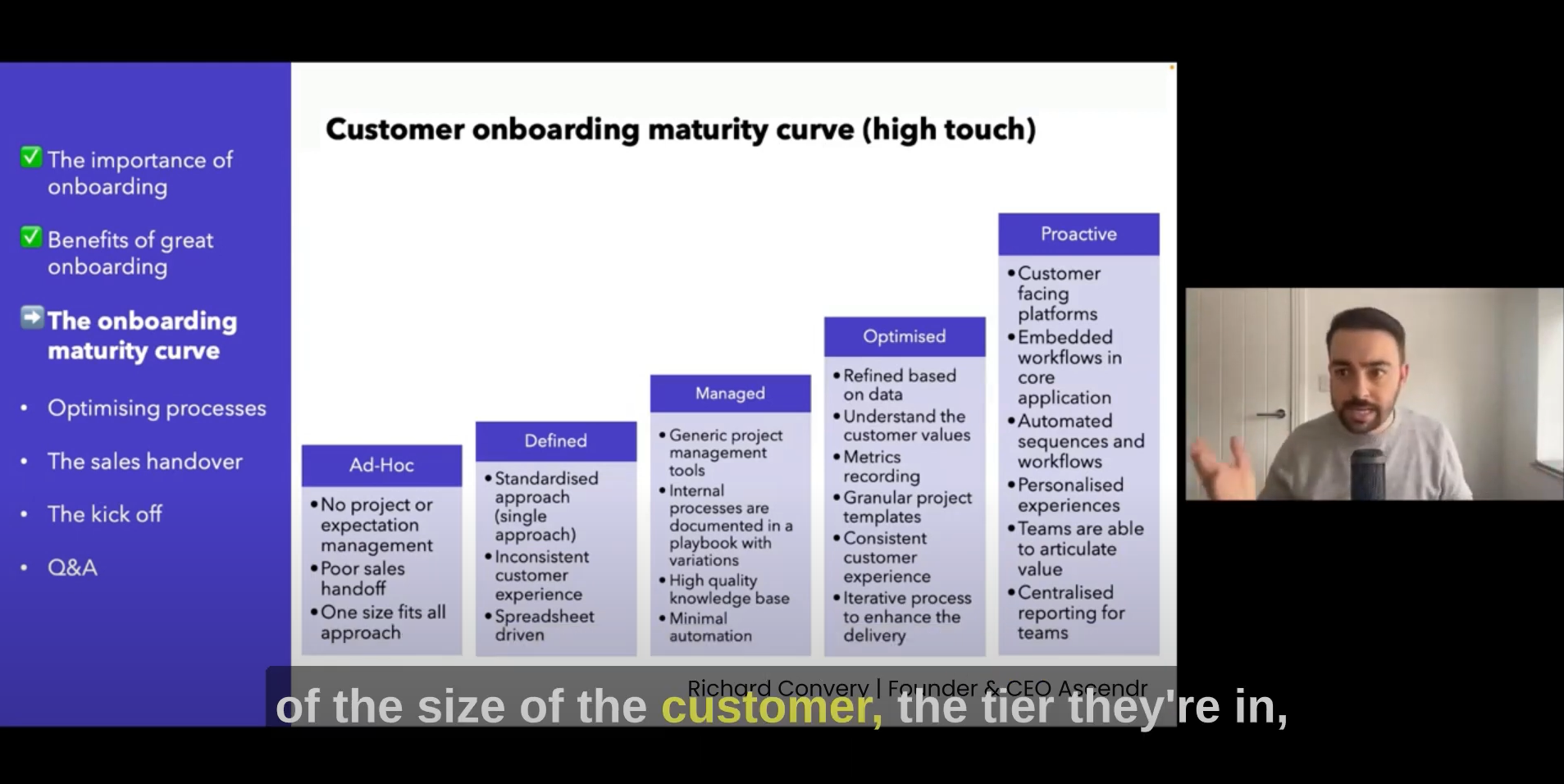Navigating the Customer Onboarding Maturity Curve: A Guide for Customer Success Leaders
When I first started working in customer onboarding, things were often chaotic. Processes were inconsistent, communication between teams was patchy, and every customer seemed to get the same generic experience, regardless of their specific needs. Sound familiar? If you’re in a similar situation, don’t worry—you’re not alone.
Over time, I realised that onboarding isn’t something you just “get right” overnight. It’s a journey, one where you move from a reactive, often disorganised approach to a structured, proactive process that delivers real value to customers. This journey is what I call the Customer Onboarding Maturity Curve. And in this post, I’m going to share how you can navigate that curve to create an onboarding process that sets your customers up for success.
Let’s break down the curve, and I’ll share some key strategies to help you move your onboarding efforts from an ad hoc approach to a mature, proactive system.

The Customer Onboarding Maturity Curve: From Ad Hoc to Proactive
At the beginning of the curve, things can feel a bit messy. Many businesses start with an ad hoc approach to onboarding. If you find yourself here, your onboarding process likely lacks structure, and each customer gets the same experience, regardless of their needs or potential value. There’s often poor communication between sales and customer success, and expectations aren't clearly set or managed. Sound familiar?
The good news is that acknowledging this stage is the first step toward improvement. As you move further along the maturity curve, you’ll aim to transform your onboarding into something proactive. And that’s where the real magic happens.
Moving Towards Proactive Customer Onboarding
When you shift to a proactive onboarding process, everything changes. The key difference here is structure, visibility, and personalisation. Here’s what it might look like:
- Customers can log in and see real-time updates on their implementation progress.
- Your team communicates effectively across platforms and keeps customers informed at every step.
- Workflows and tasks are automated, but not at the expense of the personal touch. Automation is great for consistency, but you still need to build relationships.
One of the most important aspects of proactive onboarding is timing. Automation allows you to deliver information and requests to customers at exactly the right moments—whether it’s asking them for information, educating them on a feature, or celebrating a milestone in their journey. But proactive doesn’t mean "hands-off." It's all about balancing efficiency with a human touch. You’re still building a partnership, and it’s important that your customers feel supported, not processed.
Articulating Value, Not Just Features
Another key area that often gets overlooked is articulating the value of your product. It’s easy to focus on features, showing your customers what your application can do. But what’s more important is helping them understand why it matters.
The features of your product solve problems—real business challenges your customers are facing. And that’s the message you want to convey. Make sure your team is trained to explain the value of these features, not just how they work. Customers need to know what they stand to gain, how their lives will improve, and how your solution fits into their bigger picture. When you focus on value, you build stronger, more meaningful connections with your customers.
Centralised Reporting: A Holistic View of the Customer Journey
Proactive onboarding requires good visibility, not just for the customer, but for your internal teams too. Enter centralised reporting.
When you have a multitude of systems and data points—sales notes, onboarding progress, customer feedback, usage statistics—it’s crucial that all of this information is easily accessible in one place. Your Customer Success Managers, Implementation Consultants, and Customer Onboarding Consultants need a clear, unified view of each customer’s journey. This holistic perspective allows your team to be more strategic, make informed decisions, and ultimately deliver a better experience.
Continuous Improvement: Evolving Along the Curve
Here’s the reality: no onboarding process is perfect, and that’s okay. The important thing is to recognise where you’re falling short and take steps to improve. Moving along the Customer Onboarding Maturity Curve is about continuous evolution. It’s not about making massive changes overnight, but about small, consistent improvements over time.
Start by identifying one or two areas where your process can be refined. Maybe it’s better communication between sales and customer success, or improving the customer handoff process. Or perhaps it’s setting clearer expectations at the start of onboarding. Whatever it is, tackle one section at a time, measure the impact, and then move on to the next improvement.
Final Thoughts: Mastering the Onboarding Maturity Curve
Navigating the Customer Onboarding Maturity Curve is an ongoing journey, not a destination. By moving from an ad hoc to a proactive approach, you’ll set your customers up for long-term success, enhance their experience, and reduce churn. It’s about creating a seamless, structured onboarding process that anticipates customer needs and delivers value at every step.
So, take a look at where you currently stand on the curve, and start planning your next move. Whether it’s introducing more automation, centralising your reporting, or getting better at articulating value, there’s always room to improve.
By continuously evolving your onboarding process, you’ll not only transform your customer experience, but you’ll also build a foundation for lasting success.


SUBMIT YOUR COMMENT